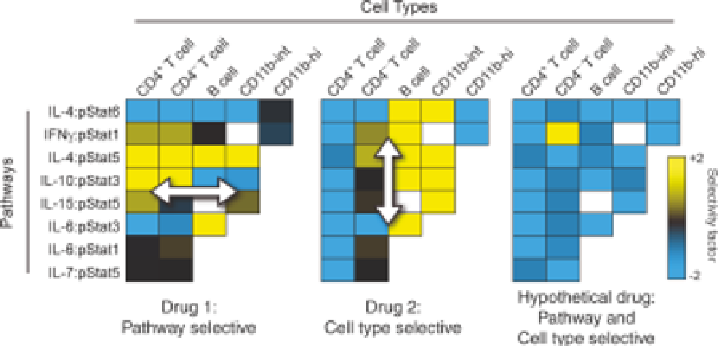Biomedical Engineering Reference
In-Depth Information
FIGURE 15.5
Phospho flow enables identification of both pathway and cell type selective
drugs. Shown are the selectivity fingerprints of two different compounds when analyzed on five
cell types and eight signaling pathways in primary immune cell populations. The selectivity
factor is a measure of the relative inhibitory effect of a compound on the different pathways or
cell types, with yellow indicating potent inhibition (low IC
50
values) and cyan indicating weak
inhibition (high IC
50
values). Drug 1 (left) displays a pathway selective profile (horizontal
pattern), inhibiting IL-4:pStat5 and IL-10:pStat3 strongly, while having relatively less effect on
IL-4:pStat6, IL-6:pStat1, and IL-7:pStat5. Drug 2 (center) displays a cell type selective profile
(vertical pattern), inhibiting B cells and CD11b-int cells potently across all the signaling
pathways measured. Also shown is a hypothetical selectivity fingerprint (right) of an ideal
compound that is able to inhibit one pathway, IFN
g
:pStat1, in only one cell type, CD4
T cells.
Such a compound could target an aberrant signaling pathway in a cell subset that drives a
disease without having negative side effects in other cell populations. Phospho flow is a unique
platform for identifying these types of compounds in complex primary cell populations. (See
the color version of the figure in the Color Plates section.)
determine a selectivity factor. The selectivity factor is a metric that describes whether
a particular signaling pathway or cell type is inhibited more or less easily than the
other pathways evaluated for any given drug. Therefore, the selectivity factor is a
normalized score for each drug allowing us to compare patterns of inhibition rather
than potency alone.
By clustering the 27 cell type-pathway combinations according to their selectivity
factors across the 8 drugs tested, we observed two clear trends of druggability
(Figure 15.6). First, some signaling pathways were more easily inhibited than others.
For instance, although IL-4 induced both Stat5 and Stat6 phosphorylation, across the
eight drugs we tested, the Stat5 pathway was inhibited at 10-fold lower doses than the
Stat6 pathway. Therefore, even though both Stat5 and Stat6 are induced by the same
upstream receptor, the Stat6 pathway is more “strongly” induced and is more resilient
to drug inhibition. Stat5, on the other hand, is “weakly” induced and is more
druggable. In this particular case, the magnitude of the signaling induced through
these two proteins is different and may explain why Stat5 is more easily inhibited.

Search WWH ::

Custom Search